1. The "20-20-20" targets for 2020
The European Union (EU) has a long-term goal of reducing Europe’s greenhouse gas (GHG) emissions by 80 % by 2050, compared with 1990 levels. In the context of its commitments and the negotiations at international level, in March 2007 the European Council committed the EU to becoming a highly energy-efficient, low-carbon economy by achieving three domestic climate and energy objectives by 2020 (European Council, 2007):
- to reduce GHG emissions by 20 % compared with 1990 levels;
- to increase to 20 % the proportion of renewable energy sources (RES) in the EU’s gross final energy consumption;
- to improve the EU’s energy efficiency by 20 %.
To achieve these domestic commitments, in 2009, the EU adopted the climate and energy package, which comprises various pieces of legislation (EU, 2009a, 2009b, 2009c, 2009d, 2009e and 2009f). The package introduced a clear approach to achieving the 20 % reduction in total GHG emissions, compared with 1990 levels, which is equivalent to a 14 % reduction compared with 2005 levels. This 14 % reduction objective is to be achieved through a 21 % reduction compared with 2005 levels for emissions covered by the Emissions Trading System (ETS), and a 9 % reduction for sectors covered by the Effort Sharing Decision (ESD) (EU, 2009b).
A revision of the ETS Directive (EU, 2009a) introduced a single 2020 target for all EU emissions covered by the EU ETS (as well as ETS emissions from the three participating non-Member States, namely Norway, Iceland and Liechtenstein). The ETS essentially covers emissions from large industrial installations, as well as emissions from aviation. ETS emissions represent about 40 to 45 % of total EU GHG emissions. The 2020 cap corresponds to a reduction of about 21 % in ETS emissions by 2020, compared with 2005 levels. The sectors covered under the EU ETS are therefore expected to contribute the largest proportion of emission reductions in the context of meeting the EU’s 2020 GHG emissions target. For allowances allocated to the EU ETS sectors, annual caps have been set for the period from 2013 to 2020; these decrease by 1.74 % annually. For further details on the EU ETS in the 2013–2020 period, see EEA, 2016.
For all other emissions not covered by the EU ETS, the ESD has set annual binding targets for each year of the period between 2013 and 2020, for each Member State.
These EU-internal rules under the ‘2020 climate and energy package’ underpin the EU implementation of the 2020 target under the United Nations Framework Convention on Climate Change (UNFCCC) (see section A1.3).
2. The 2030 climate and energy framework
To ensure that the EU is cost-effectively attaining its long-term objective, EU leaders agreed, in October 2014, on a 2030 climate and energy policy framework for the EU, and endorsed the following targets (European Council, 2014):
- A binding target of at least a 40 % domestic reduction in GHG emissions, compared with 1990 levels, was agreed. The 40 % domestic reduction target for GHG emissions will ensure that the EU is on track to cost-effectively meet its objective of cutting emissions by at least 80 % by 2050. This target will be delivered collectively, with a 43 % reduction in the ETS sectors and a 30 % reduction in the non-ETS sectors by 2030, compared with 2005 levels. In the EU ETS, the annual factor that reduces the cap on the maximum permitted emissions will be changed from 1.74 % to 2.2 % from 2021 onwards. In non-ETS sectors, the methodology for setting the national reduction targets, with all the elements as applied in the ESD for 2020, will be slightly amended for 2030. Efforts will be distributed on the basis of relative gross domestic product (GDP) per capita, but targets for Member States with a GDP per capita above the EU average will be adjusted relatively, in order to reflect cost-effectiveness in a fair and balanced manner. All Member States will contribute to the overall EU reduction in 2030, with the targets ranging from 0 to −40 %, compared with 2005 levels.
- A target for renewable energy consumption of at least 27 % of total energy consumption was set. This target is binding at EU level, but with no fixed targets for individual Member States. This target is intended to provide flexibility for Member States to set their own more ambitious national objectives for increased renewable energy use, and to support them, in line with the state aid guidelines, as well as take into account their degree of integration in the internal energy market.
- An indicative target was set at EU level of at least 27 % for improving energy efficiency, compared with projections of future energy consumption, based on the current criteria (i.e. projections of energy consumption in 2030 from the 2007 Energy Baseline scenario from the European Commission). The target will be reviewed in 2016, having in mind an EU level of 30 %.
Neither the renewable energy target nor the energy efficiency target will be translated into nationally binding targets. Individual Member States are free to set their own higher national targets.
These targets for 2030 were submitted to the UNFCCC on 6 March 2015 as an intended nationally determined contribution (INDC) for the Paris agreement of December 2015.
The European Commission proposed in 2016 to integrate the LULUCF sector into the EU 2030 Climate and Energy Framework from 2021 onwards. The proposal includes also modified accounting rules.
The adoption of the Framework Strategy for a Resilient Energy Union with a Forward-Looking Climate Change Policy (EC, 2015a) underlined the importance of meeting the 2030 targets as the priority ‘Energy Union and Climate’ was identified as one of 10 priorities at the start of the Juncker Commission’s term. This priority comprises five ‘dimensions’ (i.e. ‘supply security’, ‘a fully integrated internal energy market’, ‘energy efficiency’, ‘climate action — emission reduction’ and ‘research and innovation’), which are all now reported on annually in the State of the Energy Union (EC, 2015b). The annual reporting of progress is considered essential so that issues can be identified in a timely fashion and addressed, if necessary, through further policy interventions.
3. National targets and compliance under the Effort Sharing Decision
Targets for 2020
The ESD covers emissions from all sources outside the EU ETS, except for emissions from aviation [1] and international maritime transport, and net emissions from LULUCF. The ESD therefore includes a range of diffuse sources in a wide range of sectors such as transport (cars, trucks), buildings (in particular heating), services, small industrial installations, agriculture and waste. Such sources currently account for almost 60 % of total GHG emissions in the EU.
The ESD sets individual annual binding targets for GHG emissions not covered by the EU ETS for all Member States for the period from 2013 to 2020 (annual emission allocations (AEAs)) (EU, 2009b). In 2013, the European Commission determined the AEAs of Member States for the period from 2013 to 2020, using reviewed and verified emission data for the years 2005, 2008, 2009 and 2010 (EC, 2013a). The AEAs were later adjusted to reflect the change in ETS scope from 2013 onwards (EC, 2013b) [2].
Each Member State will contribute to this effort, according to its relative wealth in terms of GDP per capita. The national emission targets range from a 20 % reduction for the richest Member States to a 20 % increase for the poorest ones by 2020, compared with 2005 levels (see Figure A2.0.1). At EU level, this will deliver an approximately 9 to 10 % reduction in emissions by 2020, compared with 2005 levels, from those sectors covered by the decision. The least wealthy countries are allowed to increase emissions in these sectors because their relatively higher economic growth is likely to be accompanied by higher emissions. Nevertheless, their targets still represent a limit on emissions, and a reduction effort will be required by all Member States; they will need to introduce policies and measures to limit or lower their emissions in the various ESD sectors.
Proposed 2030 targets
On 20 July 2016, the European Commission presented a legislative proposal, the ‘Effort Sharing Regulation’, which sets out binding annual GHG emission targets for Member States for the period 2021–2030 (EC, 2016a). The proposal is the follow-up to the ESD, which established national emission targets for Member States in the non-ETS sectors between 2013 and 2020. The proposal recognises the different capacities of Member States to take action by differentiating targets according to GDP per capita across Member States. This ensures fairness because Member States with the highest incomes take on more ambitious targets than Member States with lower incomes. EU leaders recognised that an approach for high-income Member States based solely on relative GDP per capita would mean that, for some, the costs associated with reaching their targets would be relatively high. To address this, these targets have been adjusted to reflect cost-effectiveness for Member States with an above average GDP per capita. In line with the guidance of the European Council, the resulting 2030 GHG emission targets range from 0 to –40 %, compared with 2005 levels (see Figure A2.0.1).
Allowed flexibilities under the ESD
The ESD allows Member States to use flexibility provisions in order to meet their annual targets, with certain limitations:
- Within the Member State itself, any overachievement in a year during the period from 2013 to 2019 can be carried over to subsequent years, up to 2020. Up to 5 % of a Member State’s annual emission allocation period may be carried forward from the following year during the period from 2013 to 2019. Where the emissions of a Member State are below that annual emission allocation, excess emission reductions can be carried over to the subsequent years.
- Member States may transfer up to 5 % of their AEAs to other Member States, which may use this emission allocation until 2020 (ex ante). Any overachievement in a year during the 2013 to 2019 period may also be transferred to other Member States, which may use this emission allocation until 2020 (ex post).
Member States may use emission credits from the Kyoto Protocol’s flexible mechanisms according to the following provisions:
- The use of project-based emission credits is capped on a yearly basis up to 3 % of 2005 ESD emissions in each Member State.
- Member States that do not use their 3 % limit for project-based credits in any specific year can transfer their unused credits for that year to other Member States, or bank it for their own use until 2020.
- Member States fulfilling additional criteria (Austria, Belgium, Cyprus, Denmark, Finland, Ireland, Italy, Luxembourg, Portugal, Slovenia, Spain and Sweden) may use credits from projects in the least developed countries (LDCs) and small island developing states (SIDS) for up to an additional 1 % of their verified emissions in 2005. These credits are not bankable or transferable.
Overall, a maximum of Kyoto emission credits equivalent to 750 Mt CO2 at EU level can be used during the 2013 to 2020 period. As most Member States are expected to meet their ESD targets (see section 3.4) without the flexibility provisions, while other Member States can meet their ESD targets through intra-EU transfers of AEAs, the use of project credits is expected to be significantly smaller.
Any Member State exceeding its annual AEA, even after taking into account the flexibility provisions and the use of Kyoto emission credits, will have to take corrective measures as laid down in the ESD and will be subject to the following consequences:
- a deduction from the AEA for the next year of the excess non-ETS emissions multiplied by 1.08 (8 % interest rate);
- the development of a corrective action plan — the European Commission may issue an opinion, possibly taking into account comments from the Climate Change Committee;
- the transfer of emission allocations and project-based credits from the account of that Member State will be temporarily suspended while the Member State is in a state of non-compliance with its ESD obligations.
The proposed ‘Effort Sharing Regulation’ for 2030 non-ETS targets maintains existing flexibilities under the current ESD (e.g. banking, borrowing, buying and selling) and provides two new flexibilities to allow for a fair and cost-efficient achievement of the targets. These new flexibilities are as follows:
- A new one-off flexibility to access allowances from the EU ETS. This allows eligible Member States to achieve their national targets by covering some emissions in the non-ETS sectors with EU ETS allowances that would normally have been auctioned. EU wide, this cannot be more than 100 million tonnes CO2 over the 2021–2030 period. Eligible Member States have to notify the Commission before 2020 of the amount of this flexibility that they will use over the period. Since the transfer is strictly limited in volume, and decided beforehand, predictability and environmental integrity are maintained.
- A new flexibility to access credits from the land-use sector. In order to stimulate additional action in the land-use sector, the proposal allows Member States to use up to 280 million credits over the entire 2021–2030 period from certain land-use categories, in order to comply with their national targets. All Member States are eligible to make use of this flexibility, but more access is available for Member States with a larger proportion of emissions from agriculture. In line with EU leaders’ guidance, this recognises that there is a relatively low mitigation potential for emissions from the agriculture sector.
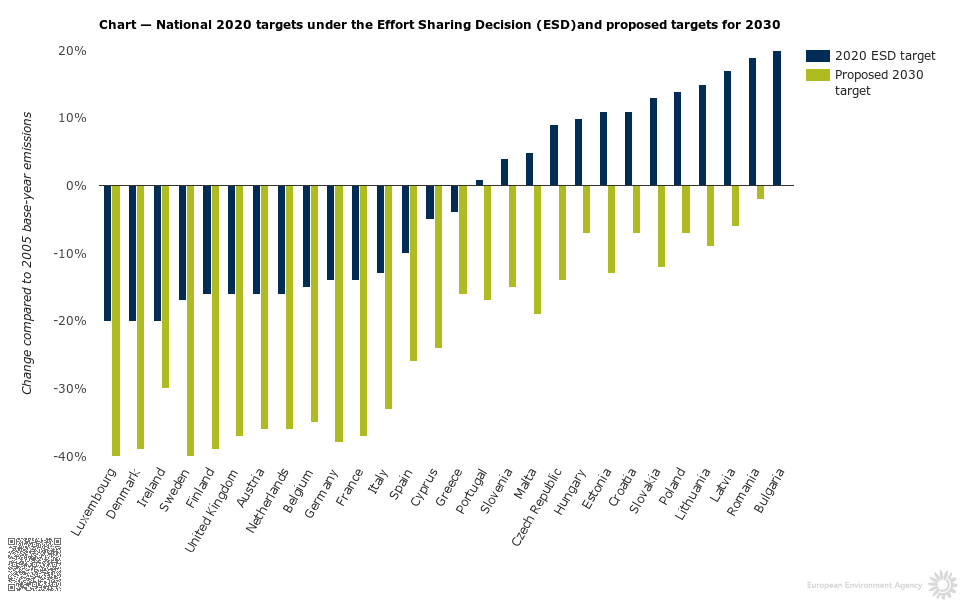
Note: The targets are expressed relative to 2005 ESD base-year emissions. These base-year emissions calculated on the basis of relative and absolute 2020 targets (for details on ESD base-year emissions, please see section A3.4).
The absolute 2020 and 2013 targets used for the calculations are consistent with the global warming values in the IPCC Fourth Assessment Report (AR4) (IPCC, 2007) and take into account the change in the scope of the ETS from the second to the third period (2013 to 2020).
Source: EU, 2009b; EC, 2016a.
4. Renewable energy targets for 2020
In order to meet its target of increasing the use of RES to 20 % of gross final energy consumption by 2020, the EU adopted the Renewable Energy Directive (RED) (EC, 2009c) as part of the climate and energy package.
The RED includes legally binding national renewable energy targets for 2020, consistent with an EU-wide target of increasing RES use to 20 % of gross final energy consumption by 2020, and to 10 % of transport-related fuel consumption by the same year (EC, 2009b). The RED also sets an indicative trajectory for each Member State for the 2011 to 2018 period, intended to ensure that each Member State achieves its 2020 targets. An interim indicative RED target for the EU can be derived from the minimum indicative trajectories of the Member States in the run-up to 2020 (RED, Annex I, Part B).
Under the RED, Member States had to submit national renewable energy action plans (NREAPs) in 2010 (EEA, 2011). These plans outline the pathways (i.e. the expected trajectories) that Member States anticipate using to reach their legally binding national renewable energy targets by 2020. In 2011 (and every 2 years thereafter), Member States had to report on national progress towards the interim RED and expected NREAP targets. The NREAPs adopted by Member States in 2010 outline the expected trajectories for RES use, as a proportion of gross final energy consumption, towards the legally binding national 2020 RES targets.
In contrast, no national targets for renewable energy have been set for 2030 (see Section 1.2).
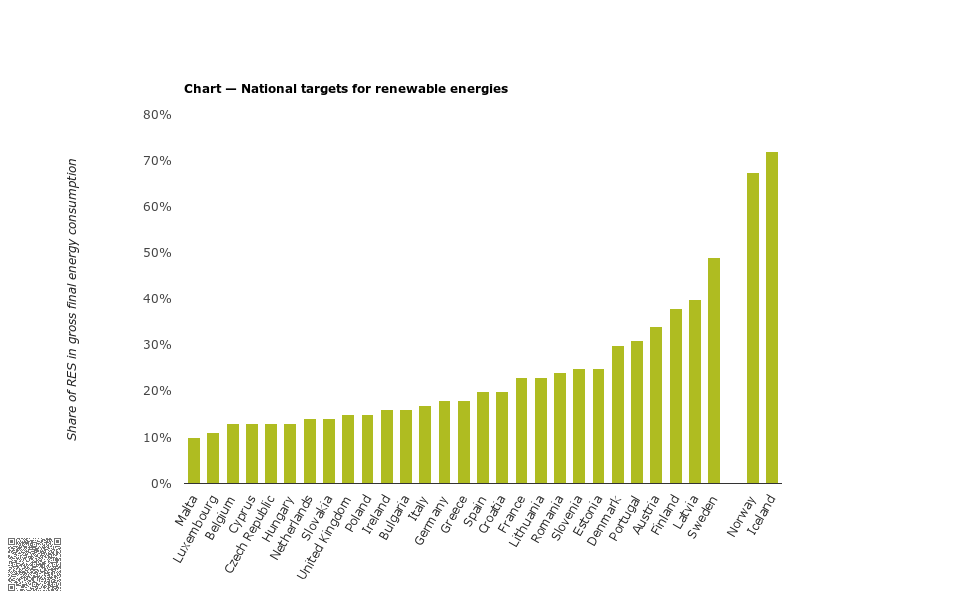
Note: The targets for Iceland and Norway, which are not EU Member States, were agreed and included in the annex of the European Economic Area agreement. For the sake of simplicity, the report refers to these as RED targets.
Source: EC, 2009c.
5. Energy efficiency targets for 2020
In 2007, the European Council (European heads of state or government) stressed the need to increase energy efficiency in order to achieve the 20 % energy savings target for 2020, for primary energy consumption, and agreed on binding targets for GHG emission reductions and renewable energy (Council of the European Union, 2007). The reduction of primary energy consumption by 20 % by 2020 is a non-binding objective in the EU.
The climate and energy package does not address the energy efficiency target directly, although the CO2 performance standards for cars and vans (EU, 2009d and 2014a), the revised EU ETS Directive and the ESD all contribute to fostering energy efficiency. Since the adoption of the package, the EU energy efficiency policy framework has advanced in line with the priorities identified in the Action Plan for Energy Efficiency 2006 (EC, 2006). The energy efficiency action plan was reviewed in 2011, after revisions of the following pieces of legislation:
- the Ecodesign Directive (EU, 2009g);
- the Energy Labelling Directive (EU, 2010a);
- the Energy Performance of Buildings Directive (EPBD) (EU, 2010b).
One of the key developments in the energy efficiency policy framework was the adoption of the Energy Efficiency Directive (EED) in 2012 (EU, 2012). The EED establishes a common framework of measures for the promotion of energy efficiency within the EU and aims to help remove barriers and overcome market failures that impede efficiency in the supply and use of energy. The EED stipulates that primary energy consumption in the EU should not exceed 1 483 million tonnes of oil equivalent (Mtoe) in 2020, and that final energy consumption in the EU should not exceed 1 086 Mtoe in 2020. These absolute targets were set using the European Commission’s 2007 Energy Baseline scenario (EC, 2011), based on the Price-driven and Agent-based Simulation of Markets Energy System Models (PRIMES). Implementing the EED was expected to lead to a 15 % reduction in primary energy consumption compared with the 2007 Energy Baseline scenario, with an additional 2 % reduction expected from the transport sector (Groenenberg, 2012).
Under the EED, Member States had to set indicative national targets and implement a set of mandatory requirements, one of the most significant being the establishment of an Energy Efficiency Obligation (EEO) scheme, or the implementation of alternative measures.
Member States have adopted different base years against which the progress towards national energy efficiency targets will be measured. Member States also chose different approaches for setting national targets. A total of 10 Member States (Austria, Belgium, Cyprus, Denmark, Hungary, Ireland, Italy, Latvia, Malta and Poland) chose to focus their targets on primary energy consumption, while 12 (Croatia, Estonia, Finland, France, Greece, Lithuania, Luxembourg, the Netherlands, Spain, Slovakia, Slovenia and the United Kingdom) chose to focus their national targets on gross final energy consumption. Another two (Bulgaria and Sweden) have focused on primary energy intensity. Each national target reflects the specific situation of the Member State that adopted it. As a consequence, ambition levels vary greatly. Compared with 2005 levels, 16 Member States have aimed to reduce final as well as primary energy consumption; for six Member States, targets show an increase in final as well as primary energy consumption (including Malta, which has a 24 % reduction target in primary energy consumption, alongside a +40 % target for final energy consumption, compared with 2005). Five other Member States have placed a cap on the potential increase in either primary or final energy consumption over the period.
In some Member States, the targets may still be subject to change in the upcoming years. This is because some countries are currently holding nationwide debates on the future of their energy systems. Depending on the outcome of these debates, energy efficiency targets might be modified. A total of 12 Member States (Austria, Bulgaria, Croatia, Cyprus, France, Greece, Italy, Poland, Slovakia, Spain, Sweden and the United Kingdom) revised their energy efficiency targets in their triennial national energy efficiency action plans (NEEAPs) submitted under the EED.
Figure A2.0.3 shows the national targets set by each Member State under the EED, compared with 2005 levels, for primary and final energy consumption. The year 2005 is used here to serve as a common reference, although the EED does not explicitly use it as a common base year.
In contrast, no national targets for energy efficiency have been set for 2030 (see Section 1.2).
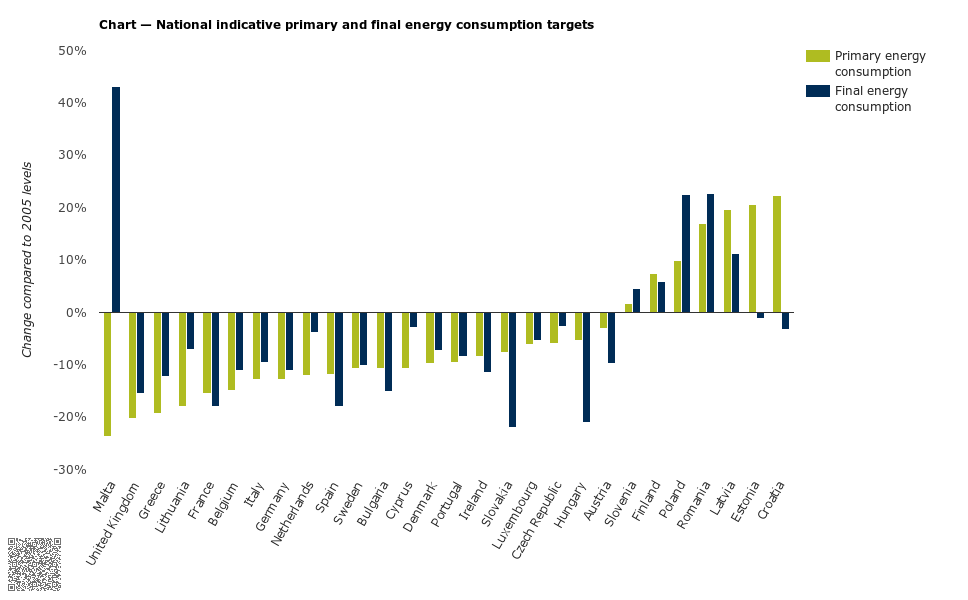
Note: The national targets for 2020 reported by Member States under the EED were first calculated in absolute terms, and then compared with 2005 levels.
Source: EC, 2015c and 2016b; EU, 2012; Eurostat, 2016a, 2016b and 2016c.
6. Overview of 2020 national climate and energy targets
The main targets that apply to Member States under international and EU commitments are presented in Table 1. The scope of existing EU legislation that implements a domestic 20 % target commitment is different from that of the Kyoto target for the second commitment period. For this reason, the total allowed emissions or the ‘emissions budget’ under the climate and energy package cannot be directly compared with the corresponding quantified emission limitation or reduction commitment (QELRC). Some of the main differences between the climate and energy package and the second commitment period, in terms of emissions included and the methodologies used to determine emissions, relate to the treatment of emissions from international aviation, emissions and removals from LULUCF, the use of units from flexible mechanisms, the coverage of nitrogen trifluoride (NF3), flexibilities regarding base years and the use of global warming potential (GWP). The differences are summarised in Table 2. For details, please see EEA, 2014, as well as Section A1.3.
Table 1 Main national climate and energy targets
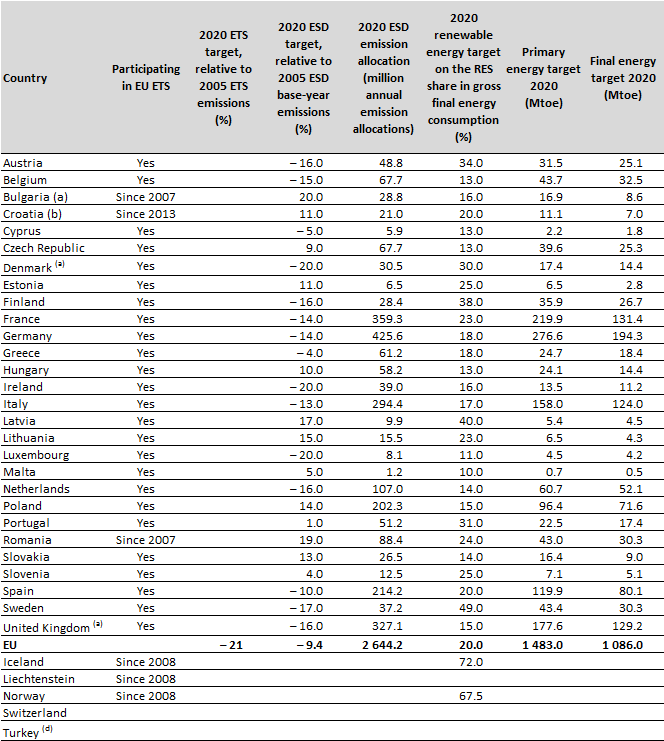
Note: (a) The Faroe Islands and Greenland (Denmark) and the United Kingdom’s overseas territories are not part of the EU and therefore are not covered by the targets presented here.
Source: EC, 2013a, 2013b, 2016b and 2016c; EU, 2009a, 2009b, 2009c and 2012.




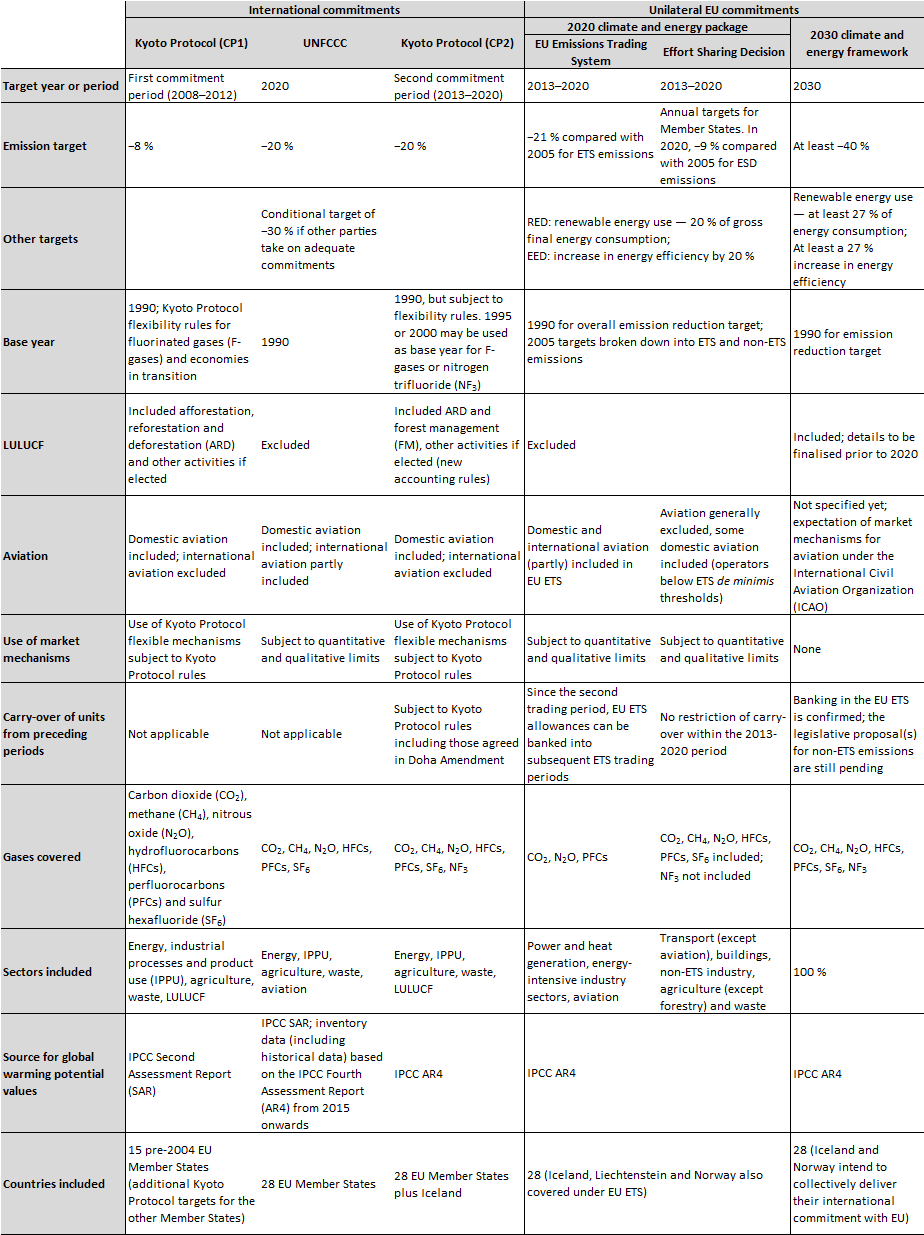
Document Actions
Share with others